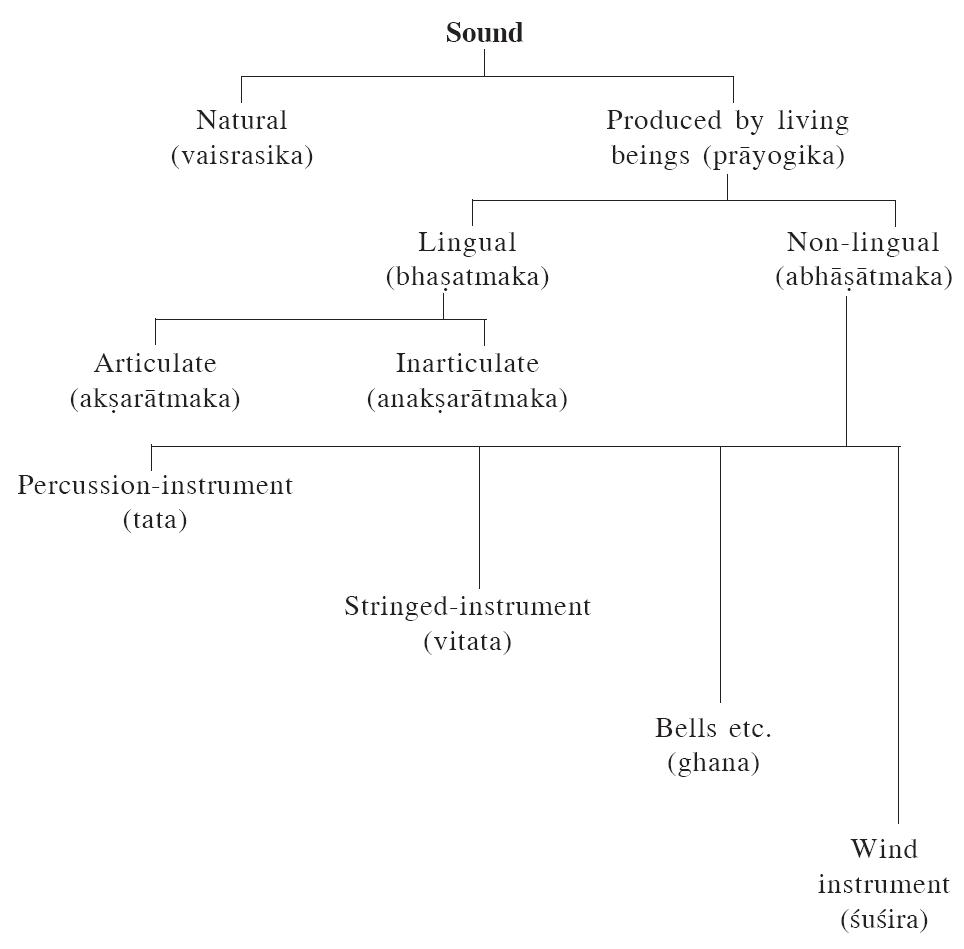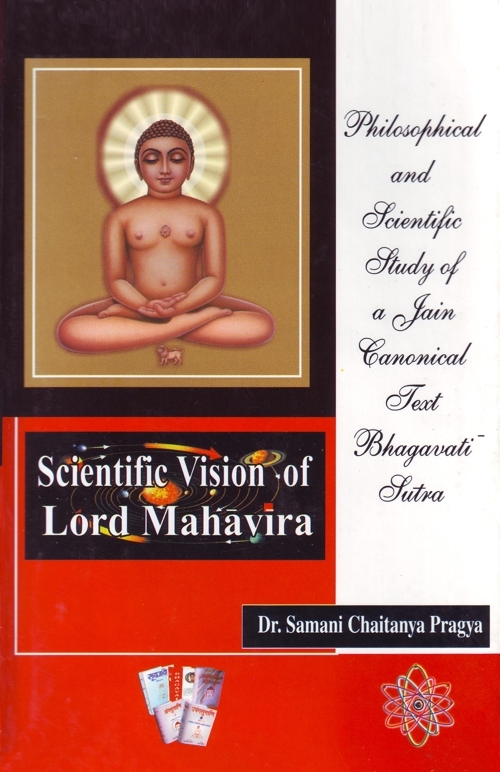Apart from the characteristic qualities the Jain texts refer to some important modes of Pudgala, viz.; sound, light and darkness; integration and disintegration; microscopicness and macroscopicness and shape or configuration.[22] Muni Mahendra Kumar has explained each one very beautifully in his book 'Microcosmology; Atom in Modern Science & Jain Philosophy.'[23] The explanation is gaining ground in modern science. Here the explanation, somehow, has been borrowed as it is.
1. Sound
The Jain seers have thought much of sound. They feel sound is produced by collision or separation of two or more physical objects. It is the agitation set up by knocking together or splitting of two aggregates. An ultimate atom cannot produce sound by itself. It is of two kinds (in respect of genesis)—(i) Natural or spontaneous, e.g. thunder and that produced by conscious effort. The latter is again of two kinds—(i) Lingual or Articulate. Articulate means which is made up of alphabetical composition, and (ii) Nonlingual or inarticulate i.e. sound produced by sub-human animals.
Non-lingual sound is produced with the help of instruments and is of four kinds:
- tata—sound produced by percussion instruments like drum.
- vitata—sound produced by stringed instruments like violin.
- ghana—sound produced by bells, etc.
- śuṣīra—sound produced by flute, and such other wind instruments.

Sound may be divided into three kinds again
- Sound produced by animate organisms.
- Sound produced by inanimate objects.
- Sound produced jointly by both.
Thus, sound is not a quality (guna) but a modification (paryaya) of Pudgala. This view can be understood through the view of science. Accordingly sound is in the form of waves produced by the vibrations of sound-producing aggregates and is propagated by material medium such as air or water but not by space i.e. in vacuum. Sound is perceived by the sense organ of hearing.
The Vaishesika philosophy does not accept sound as modification of Pudgala, but as an attribute of space. This view is patently untenable. Firstly, sound is mūrta (perceivable) by a sense-organ, while space is amūrta (imperceivable)—devoid of material qualities. The attribute of an amūrta substance can never be mūrta. For, the sound to be an attribute of space, the space must be considered as mūrta. The sound-waves are propagated dynamic, while space is static (niskriya). If it was an attriubute of space, it must inhere everywhere in space. Hence, sound is a modification of physical element.
2. Light and Darkness
Light is an attriubute of Pudgala and is the cause of visibility. Darkness, the anti-thesis of light and the cause of invisibility, is also an attriubute of Pudgala. Darkness, according to Jain belief, is not merely absence of light but is a specific combination of physical bodies in which black colour is predominant.
According to the Jain view there are three kinds of light radiations:—
- Hot effulgence (ātapa)
- Cold effulgence (udyota)
- Lustre (prabha)
Hot effulgence is the sun-light or light from a fire or a lamp etc. The emission from such sources is composed of a larger proportion of heat radiations than light, e.g. sun-light is only 35% light; lamp-light is 7 to 10%. Cold effulgence, on the other hand, predominates in light radiations, and there is very little heat, if at all. Reflection of sun-light by moon etc, falls into this kind. Light radiated from the tiny body of a glow-worm is 99% light and only 1% heat. Luster is light rays emitted by certain gems and the like.
Shadows (chāyā) and images are also produced by light, and are, therefore, physical objects.
3. Integration (Bandha) and Disintegration (Bheda)
The ultimate atom is the permanent basis of physical existence. All physical objects are constituted by the ultimate atoms which combine together to form composite bodies or aggregates. Smaller and simpler aggregates also combine together to form larger and more complex objects. Conversely, large and complex objects break up into smaller and simpler components. This synthesis or fusion and break-up or fission are eternal phenomena in the physical universe. All physical objects are the result of either integration or disintegration.
The integration is of two kinds—(i) Natural (vaisrasika) and (ii) Made by animate organisms (prāyogika). The natural, in respect of time, is again of two types: with a definite beginning and (ii) without a beginning. For example, clouds, lightening, rainbow etc. have beginning in time. As far as the physical existence is concerned, there is no integration without a beginning, either natural or made by organisms. The instances of eternal or beginningless integration are found only in the non-physical world. They are the medium of motion, the medium of rest, space and consciousness.
Integration made by living organisms is necessarily with a definite beginning and can be divided into two kinds from another aspect.
- Integration of one kind of matter with another, e.g., production of chemical compounds.
- Combination of matter with living beings.
The last one is again of two types: (i) karma-Bandha i.e.bondage or Combination of karma-particles with living beings, and (ii) No-karmabandha i.e. Combination of other groups of Pudgala with living beings.
Disintegration or break-up of physical bodies is also of two kinds:
- Natural and
- Made by animate organisms.
Natural disintegration is the spontaneous decay of the physical substances e.g. radioactive elements due to their own inherent structural properties. This kind also includes disintegration by natural forces such as wind, rain, flow of water, etc.
Disintegration produced by animate organisms is of many varieties depending upon the methods of division and separation. Some typical methods of break-up are:
- division by sawing or splitting (utkara)
- division by breaking into smaller pieces (khaṇḍa)
- division by grinding (cūrṇa)
- layer-by-layer separation (pratara)
- division by fissures (anuṭatikā)
4. Minuteness (Microscopicness) and Largeness (Macroscopicness)
The physical universe is composed of innumerable varieties of physical objects, from a microscopic sub-atomic particle to a macroscopic giant star. Both these opposite qualities are, therefore, special attributes of the physical substance (Pudgala). Largeness and minuteness are, however, mostly relative. An object is large because there is another one which is smaller than it. Largeness of the former is strictly relative to the minuteness of the latter. An ultimate atom (paramāṇu) is the smallest indivisible form of Pudgala, and there is nothing more minute than it and hence minuteness (microscopicness) is of two kinds:
- Relative
- Ultimate
Similarly largeness (macroscopicness) is also of two kinds:
- Relative
- Ultimate
The ultimate macroscosmic object is called acitta mahbskandha i.e. great aggregate which pervades the entire cosmic space.
5. Shape/Configuration (Saṁsthāna)
This is also an important attribute of the physical existence. It is related to the capability of the physical objects to extend into the three dimensional space. Shapes have infinite varieties, but they can be divided broadly into two groups:
- Regular or Symmetrical.
- Irregular or Non-symmetrical.
 Dr. Samani Chaitanya Pragya
Dr. Samani Chaitanya Pragya

